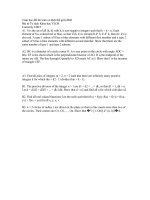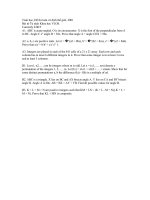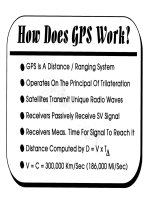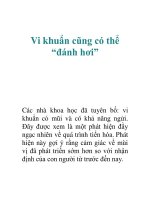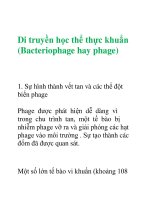THE STUDENTS'''' GUIDE pdf
Bạn đang xem bản rút gọn của tài liệu. Xem và tải ngay bản đầy đủ của tài liệu tại đây (5.28 MB, 142 trang )
THE
STUDENTS'
GUIDE
Quantitative
Analysis.
IttTENDHXJ
AS AN AID
TO T>IK
STUDY OP
FRESENIUS'
SYSTEM.
BY
H.
CARRINGTON
BOLTON,
Ph.D.,
fBOTESSOR
or CHEMtSTHV
)N
TRIHITY
COU-IOE,
HAKTFORD,
COHN.
ILL
VSTRA
TED.
THIRD
EDITION,
WITH
ADDITIONS
AND
CORRECTIONS
SECOND
THOUSAND
NEW
YORK:
JOHN
WILEY
&
SONS
1899.
COPVRIG.'tT,
iSSl,
Bv
H.
Carringtos
Boltow.
Primed
by
Braunwonh,
Muiiii& B.irbcr,
Brooklyn.
N. V U.
S. A,
L
-J
O
o
p«5
40
"in
%
&
O
to
o
<
U
U
u
o
>
>
o
PREFACE.
A
portion of
the
following
pages
originally
appeared
In
the
columns
of the
American
Chemist,
under the
title:
^'Schemes
of
Analyses
execrtted
in
the
School
of
Mines,
Cohimbia
College."
Numerous
applications
for
copies
in
book
form
have
induced
the
author
to
publish
the
Schemes
under a
more
general
title.
Since
writing the
articles
the
author
has
been
called
to
another
sphere of
labor,
and
the
circumstances
which
led
to
their
compilation
are
explained in
the
following para-
graphs,
quoted from
the
prefatory
remarks
accompanying
the
original
publication.
"
The system of
instruction
in Quantitative
Analytical
Chemistry,
organized in the School of
Mines,
Columbia
College, by Dr. C. F.
Chandler, has been
developed
by the
Assistants,
who have had charge of the Laboratory for
Quantitative Analysis,
Mr.
Alexis
A.
Julien,
Dr. Paul
Schweitzer,
and
the writer.
The
practical
examples and the methods
of analysis were
originally
selected by Prof. Chandler;
the latter have
been
modified by
the
Assistants, and from
time
to
time
they
have introduced
new processes,
conforming
to
the advances
made in this department
of
chemical
science.
i.
PREFACE.
The
plan
oi
the
Students'
Guide
is
similar to
that
in
the
cxcclkiU
papers
of
Mr.
Alexis
A.
JuUcn
entitled
;
"Examples
for
Practice
in
Quantitative
Analysis,"
the
details,
however,
arc
the
result
of
observing
the needs o£
studeiUs
during
my
five
years'
experience
in teaching
large
classes.
The
fragmentary
character
of
many
portions
of
the
notes
is
accounted
for
by
the
fact
that
they
are
intended
to
serve
in
part
as
lecture notes,
and
to
indicate
to the
student
the
points to
be
studied.
Kkesenius'
"
SysUm
of
litstmclion
in
Quantitative
Chemical
Analysis"
(American
edition, by
Profs.
O.D.
Allen and
S.
W.
jolmson
;
New
York,
I
S8i)
is
placed in
the
hands
of
each
student
on
entering
the
laboratory,
but
many
students
are
perplexed
by
the
peculiar,
though
systematic,
arrangement
of
this
classic
worli,
and
are at
a loss
to
know
how to
begin
work,
ivhat
io study,
and
where to
find
the
information
appropriate
to
particular
cases.
To
aid the
student
in the study
of
Fresciiius'
work,
and not
to
displace
it, is
one of the
objects of
the
STUnENTS.'
Guide.
It is
then scarcely
necessary
to
state
that
very
free use has
been made
of
Frescmtis' System;
acknowl-
edgment
is,
however, made in all cases.
By
occasional
references to
original papers the
student's
attention
is
directed to methods, as
detailed by their
authors,
with the
hope of encouraging
the
student in
research,"
H,
C. B.
Trinity
College,
LIST
OF
ANALYSES.
List ot
Aoilyteis.
i,
BarSc
chloHdc,
3.
Magnetic
siiSphate,
J.
Amuwnio-ftfi-ic
tiiilphate,
5.
Hj'drodiscdic
phosphate,
6.
Silver
coin,
J,
Dolomite,
S.
Bronze^
cy. Coal,
10.
Coppfir
fiyrites,
It.
Alkalimetry,
12.
Acuiimetryj
13,
Chlorimctr;^,
l.f.
Type
Hiatal,
jj,
;5ir(i;orc,
16.
Chromic
iron ore,
17.
Pyrolusite,
iS.
Feldspar,
19.
Slag,
;o.
liijmatilia,
St.
Titanifeoiis
Iron ore,
13.
Pig
iron.
I^,
?!icHol
ore,
2^.
Ar5cnopyrJt«,
iJa.
CI, 11,0.
>[!iO,
sn,,
11,0.
yO^,
Nil.,
l'V,0,j
l>y
i,yriitiO!i,
by
pre-
cipUiition
;iikI
volmiK'lrically,
K,
CI,
KA,Oi
Pfii,
H,0
by
direct
weight.
Au,
A«,
Cu,
I'b.
CaO.
MgO,
HiO,,
I'cj
),,
CO,
by
los«
and
byUii-ect
wciglit.
Cis, S«,
Z«.
H,0,
volatile
matter,
fixed
carbon,
asli, S.
Cu,
ill
diipricat<3.
Soda
A^h,
peari
ash.
Vinegaf,
iiydj'odhloric
acid.
Bkachingr
powder.
Pb, Sa,
Sb,
Zn.
Zn.
Ct,0,.
MnO,.
SiO,,
A1,0„
K,0,
Na,0.
SiO.,
AljOj,
CaO,
MgO,
FcO,
MaO,
SiO,, Fc,
S iirtd R
Complete
analysis.
Fe.
Mn,
graphite^
combined G, T\
S,
Si.
Ni. Co.
A«.
vm
LIST
OP
ANALVSES.
Ui(
oJ
Ao«l]Fi«>.
ij.
Guano.
s6.
Superpliosphat*
of
lime,
27,
Water,
2S.
Specific
gravity of
a
«olid,
39,
*'
"
"
liquid,
30,
Sugar.
jt.
Potass
ic
ferrocyan!c!«,
32.
Oil of
turpentine,
33.
Urine,
3+.
Milk,
3j.
K
aw sugar,
36.
Petroleum,
Constituents
IQ t*
<l«*nntiieA
P,0„
CaO,
MgO,
Fe,0„ SiO„
!i,0
NHji
SO,,
organic matter.
P,Oj
soluble,
precipitated,
and in-
soluble.
CaO,
MgO,
Na,0,
K,0,
SO,,
CI,
SiO,,
organii:
rrsattcr.
Heavier,
lighter
than, and
solublti in
water,
minarais
and
allo^-s.
By the
lla<k,
by
hydrometer,
and by
weighinij a solid
in the
liquid.
C, H, O.
N by
Willand
Varrentrapp's,
and
iJeSseos*
ractliods,
C.
II.
Qualit.itive and
quantitative.
Water,
tjuttcr,
casein,
sugar,
ash.
Water,
crystalli stable
cane
sugai
grape
sugar,
ash.
Fractional
distillation,
specific
grav
Hy,
fire teat.
INTRODUCTORY
NOTES.
By
means
o£
Chemical
Analysis
we
determine
the
com-
position
of
any
substance.
The
object
of
Qualitative
Analysis
is to
determine
the
nature
o£
the
constituents
of a
body.
The
object
of
Quantitative
Analysis
is
to
determine
the
amount
of
these
constituents.
Quantitative
Analysis
includes
two
methods,
Gravimetric
attid
Volumetric
Analysis.
In
Gravimetric
Analysis
we
convert
the
lcno\vn
cousritu-
ents
o£
a
compound
into
such
forms
as
will
admit
of
their
exact
determination
by
weight.
This
is
done
chiefly
in
two
ways
:
1st
By
separating
one
of
the
constituents
of
a
body
as
fuch
{e.g.,
Cu
by
the
battery),
2nd,
By
converting
an
existing
constituent
into a
new
form
by
e^cchange
of
elements
{e.g.,
AgN03+HCl
=
AgCl
+HNOj).
The
forms
must
fulfil
two
conditions:
1st
Must
be
capable
of
being
weighed
exactly.
2nd,
Must
be
of
known
atid
fixed
composition.
3j
INTKODUCTOKV
NOTES.
The
choice
of
form
of
precipitate
depends
on
two comid-
eratian.'S,
The
most
preferable
are—
I St,
Those
most
ii\solubIc
in
the
surroundiiig
liquid
2ml
Those
in
which
the
proportion
of
the
constituenti!
to
be
determined
is
very
smalt
compared
with
the
weight
of
the
precipitate
(t'.j^,,
S
In
BaSO,
is
only
T3.7
per
cent.).
In
Volumetric
Analysis
the
amount
of a
constituent
is
estimated
by
the
action
of
reagents
in
solutions
of
known
strength
and of
determined
volumes.
(Sec
Notes
on
Vol-
umetric
Analysis,
p. 40).
WORKS
FOR
REFERENCE
AND
FOR
STUDY.
^
„,
\
Sv«cm
of
Instruclion
m
Quantitative
Chem-
^^Z::^
"^JlZ
Ledcan,
Jol.
Wile,
a.d
Son.
New
York,
1881
;
last
English
;
last
German.
r^ /
QuantUative
Chemic.l
Analysis.
New
York,
last
edition.
.
.
R,s^,
//.
Traits
Complet
de
Chimie
Analytique.
fans,
1850-62.
2
vols.
.
^
//.,
and
yy^/
Handbuch
der
amlytischen
Chenne.
Leipzig,
1S67.
_
T^^tr^rmpth-
Mr.
Lehrbuch
der
cUemisch-analyt.schen
lUnrmcth
ode
Braunschweig,
last
edition.
^«m
Sy.ten.atic
Handbook
of
Volumemc
Analysis.
London,
last
editiotx.
,
J?a>m>.Me.s.
Leitfaden
ftlr
die
quantUative
cbemische
Analyse.
Berlin,
1S63.
Crook^s.
Seket
Methods
in
Chemical
Analysis.
London,
last
edition,
,
,
,
v
^o/ley
and
E.
K,pp-
Handtuch
der
techn.sch-chemi.chen
Untersuchungen.
Leipzig,
last
edition,
Wshkr
Die
Mineral
Analyse
in
Beispielen.
Gottingen,
,861.
Also
iramiation
by
Henry
B.
Nason.
Philadelphia,
1871.
PrescoU.
Outlines
of
Proximate
Organic
Analysis.
Van
NostTand,
New
York,
last
edition.
Caldwell
Agricultural
QuilitatWe
and
Quantitative
Chem-
ical
Analysis,
New
York,
last
edition.
Xli
U'ORKS
FOE
REIEREN.CE
^KD
FOR
STUDY.
Wankly>r
\Val(;r
Ar.alysis.
London,
last
edition.
Mu.s.n.
Ankitung
.ur
Analyse
Uer
Aschex.
und
Mmet.!-
wasser.
Heidelberg,
1S74.
je,V^v^/
Notes
on
Assaying
and
Assay
Scheme
Nev.
York,
Wiley
&
Sons
;
last
edition.
Sforer.
First
Outlines
of
a
Dictionary
of
SoKibilUies
of
Chemical
Substances.
Cambridge,
1864.
/l€PP^
Die
Chemlsche
Reactionen
der
wichtigsten
anor-
ganiscLn
und
otgani.chcn
Stoffe.
(Tabellen,
etc.)
Leip.ig,
'Itihchrift
fur
Analytisdie
Chemic,
Frescnius.
Wiesbaden,
1862
to
date.
Jahre.btrkht
Ubcr
die
Fortschntte
der
Chemie.
Giessen,
XS47
to
date.
BuHeHn
de
la
Soci6t^
Chimkiue
de
Paris.
Paris, 1864
to
date.
Chemical
Nat^s.
Crookes.
London,
1S60
to
date.
American
ChevmL
Chandler.
New
York,
iS?
0-7
7.
American
Journal
of
Sdaia
and
Art.
J.
D.
and
E. S.
Dana.
New
Haven,
iSrg to
date.
Journal
of
Analytical
Chcmhtry,
Edward
Hart.
Easton,
1S87 to
date.
THE
STUDENTS'
GUIDE
irt
QUANTITATIVE
ANALYSIS.
Amlysis
No.
I.—
Baric
Chloride.
BaCU
+
2H,0.
A,
—
Determination
of
Chloriii©.
See
Fies,
Quant,
Anal.,
|
141. L
a,
and
pages
790
to
795.
(References
are
to
Fresenius'
QimuUiaiivc
An^fysts,
American
edition,
tS8i.)
r\ a
Weigh
out
0,8
to
I
grm. of
powdered
BaC^-f
sH.O
and
dissolve
in
cold
water
in a
beaker
;
add a
slight
excess
of
AgNOj
previously
acidulated
with
HNO3;
stir
well,
and
warm.
When
the
precipitate
of
AgCl
has
entirely
settled,
and
the
supernatant
liquid
is
quite
clear,
pour
off
through
a
No.
2
filter;
then
add
boiling
water
slightly
acidulated
with
HNO3,
to
the
precipitate
in
the
beaker;
stir, and.
after
the
precipitate
has
settled
again,
pour off
through
the
filter.
Continue
this
washing
by
decantation
three or
four
times;
then
bring
the
precipitate
on
the
filter by
means
of
a
glass
rod
qv a
feather
;
wash
it
down into
the
point
of
the
filter;
wash laistly
with
a
little
non-ackhfied
water
;
cover
the
funnel
with
paper
;
label
properly,
and set
aside
to
dry.
Weigh
a
clean
porcelain
crucible;
transtcr
j^
QUANTITATIVE
ANALYSIS.
the
precipitate
to
this
crucible,
removing
tlie
AgCl
from
the
paper
as
completely
as
possible.
Wrap a
clean plati-
num
wire
around
the
rolled-up
filter,
forming
a
^'cradle;"
burn
the
filter
in
the
cradle
over
the
inverted
crucible
cover
;
do
not
let
the
ashes
fall
into the
crucible.
Moisten
the
ashes
with
cone,
HNO3
(one
drop)
;
heat
one
minute
;
add a
drop
o£
cone.
HCl;
evaporate
cautiously,
and heat
the
contents
of
the
crucible
and
cover
until
the
AgCI is
partly
fused,
avoiding
carefully
a
higher
temperature
than
necessary.
See
Fres.,
§
82,
b.
Wcish
the
crucible
and
contents.
For
calculation,
see
D.
AA.—
Second
Method,—
Compare
Fres.,
§
115,
1,
a,,'?-
Take to
0.2 to
0.5
grm,
BaCU
+
H,0
;
dissolve
in
warm
water;
acidulate with
HNOj
(free
from
chlorine);
pour
into
a
"parting flask;" add
AgNOj
in
slight
excess;
cork
the
flask,
and
shake well. When
well
settled,
wash
the
precipitate in
tlie flask
by
decantation
with
warm
water,
without
filtering.
Invert the flask,
covered
with a
watch-
glass, over a
weighed
porcelain
crucible,
placed
in a
large
porcelain
dish,
and filled with water.
Withdraw
the
watch-
glass
carefully,
allow
the precipitate
of
AgCl to
fall
into
the
crucible,
and
remove
the parting flask.
Four the
water
out
of the
crucible,
remove
the last
portions
with
filter
paper,
and
dry
on
a water-bath.
Ignite to
incipient
fusion,
and
weigh.
Note.—
The
precipitate
settles best in
presence
of
an
excess of
AgNOj.
B.—
Determination
of
Barimn.
See
Frcs.,
§
132,1,
i,
and
§
loi, I, a.
Dissolve
i to
1.5
grm.
substance
in
warm
water
;
acidulate
with
HCl
;
dilute
to
about
250
cc;
heat
to
boiling ;
when
boiling
hard,
add
dilute
HjSO,,
in
slight
excess
;
boil
some
minutes
and
then
CALCULATION
OF
ANALYSIS.
^
,
15
t
keep
warm
while
the
precipitate
settles.
Test
with a
dropof
H^SO,;
wash
with
boiliitg
water
by
decantation
;
then
bring
the
precipitate
on
a
No. 2
filter
;
wash
well
;
dry
and
ignite
precipitate
in
a
platinum
crucible
;
burn
filter
m
a
cradle
as
above,
and
add
ashes
to
contents
of
crucible.
Sec
Frcs.,
§
7 1
.
'?•
jVi,/tf._Wash
until
the
filtrate
gives
no
precipitate
with
A*NO
When
estimating
barium
in the
presence
of
nitrates,
chlorides,
etc.,
these
salts
arc
sometimes
carried
down
with
the
BaSO^.
Since
it is
impossible
to
remove
these
by
washing
with
water
alone,
treat
the
precipitate
with
very
dilute
HCl.
or
ammonie
acetate.
Cf.
Crookes'
Selea
Methods,
page
312.
C.
Determination
of
Watw
(by
Ignition)
—
In
a
weighed
crucible
weigh
out i
to
1.5
grms.
substance;
heat
very
gently
at
first
over
a
small
flame,
and
increase
the
temperature
very
gradually
;
finally,
heat
to
low
redness
;
then
cool,
weigh,
and
repeat
the
operation
until
the
weight
remains
constant.
Caution
:
avoid
too
liigh
a
temperature,
else
the
CI
will be
expelled.
When
substances
contain
large
percentages
of
water,
as
magnesic
sulphate,
hydrodisodic
phosphate,
alum,
etc.,
begin
to
expel
the
water
at
ioo-
C.
in
an
air-ba.th.
D.
Calculation
of
Analysis-—
See
Fresenius.
page
79S,
^ilao
§
196-
Make
two
state
ments,
the
first
to
determine
the
amount
of
the
desired
constituent
in
the
precipitate
obtained:
,
1
At.
Wt.
of
the
1
Actual
\
Actual
|
Mol.WUof
I
.
constituent \
=
weight
of
[
:
weight
of
\
precipitate
f
desired
J
precipitate
J
constituent.
J
1^
QUANTITATfVE ANALYSIS,
The
second
statement
determines
the
percentage
of
tjj
desired
constituent
in
the
substance
taken
;
*
Wt. of
sii!>
KtAncc
taken
Acttial
weight
of
con»tituent
I
-
too
i
''<ff«fl<««s
of
tl»
1
To
check
work, compare
with
theoretical
pcrccntasfct
when
possible.
Tfuoretual compasilion
of
crystulJizcd
barium
chloride,
Ba—
56.15
CI,
=
29.09
2H,0=
14.76
100.00
Use
ofFrcscnius'
Tables
for
the
calculation
of
analyses
Compare
Tabic
IH.
I-
res.,
page
854,
Examples:
Fe,0,
X
0.7=
2Fe,
BaOSO,
X
0,34335
=
50,.
Consdt
Table
IV.
Fres.,
pages
%^,6,
ei
seq
also
page
J^a
of eT-To
'"',
f^^
^™'-
^'^^SSO,
yielded
a
precipStaie
we
hav^r
''"^^'''
'^'''^^
^^
^^-^
"-^^
^*^«
'2
'
a3433S
*co
c^o<SS67
.007
^^^^^
.0004
°'«^^<^
*
'
0.00013
1.2074
0.41455
;^=32.7SpercentSO,
041455=50^
0.41455
KEI'ORXJjNG
ANALYSES.
E.
Reporting
Analyses.—
Analyses
may
be
reported
on blank forms printed
on
let-
ter
paper
8"
x lo", having
following headings
:
Hakti'okd,
,
!S8 . Report of
.
Analysis
OF
.
DliXEKMlNATJON OF
.
GRAMMES
TAKEN
.
Metiiod of
Analysis
,
These
headings
are
printed in vertical
colimin
;
in
one horizontal
line
are
placed
following
headings:
Pkecii'ITATes,
Actual
Weights,
Constituents, Calculated
Weights,
Per-
centages,
Theoretical Percentages; under
each a blank
space
is left
of
2
1-2
inches. Under
"precipitates"
place
formulas of precipitates
obtained; under
"actual weights"
place
actual weighL-i of precipitates; under "constituents
"
place
forniDlcC
of constituents to be reported; under
"cal-
culated
weights
'
place the amounts
of
constituents existing
in
precipitates; under
"
percentages" place percentages
of
constituents actually
obtained
—
in
short,
the
results of
analyses. The last column,
"theoretical percentages,"
can
be fdled only in the case of
few
pure
chemical
salts.
The words special remarks
are printed about two
inches
from the bottom of the
sheet, leaving room for remarks on
processes
employed, etc.*
Notes to the Analysis
of
Barium Chloride,
Reactions. (I) BaCL
-f
H,SO,
=
EaSO,
+
2HCI
(2)
BaCI,
-\-
-AgNO^
=
2AgCl+ Ba(NO,),.
The chloride of
silver precipitate changes color
on
expos-
ure to light, losing chlorine
and forming
AgjCl ; the
change,
however, is only
superficial,
but Mulder says the
loss of
weight
is appreciable.
*
Sec scccimcs
blaok ai
the
end of this beok.
iS
(iLrANXri-ATIVE
ANALYSI ,,
When
one
part
of
silver
is
thrown
down
as
AgCJ
[^
1,000,000
parts
of
water,
a
slight
bluish
mllkiness
maystiU
be
seen.
This
cloudiness
disappears
on
adding
an
excess
of
HO.
Barium
sulphate
requires
more
than
400,000
parts
of
''
water
for
solution.
The
solubility
is
not
perceptibly
increased
by
the
preseiiee
of NaCl,
KCIO,
or
Ba(NO,)„
but
HCl
produces
a
sensible
increase.
(Cf.
Storcr's
Diction.
ary
of
Solubilities.)
Barium
sulphate
thrown
down
in
a
solution
containing
ferric
salts
is often
contaminated
with
iron.
This
becomes
evident
by the
rcddisli
color of
the
precipitate
after
ig-
nition.
The
precipitate may be purified
by
washing
with
ammoniuni
acetate, or hy solution
in
cone.
HjSO^,
and
re-
precipitation by pouring
into
water.
BaSO^
dissolves
In
cone. H.SO^ in
the ratio of
5.7
parts
to lOO,
and
in
Nord-
hausen sulphuric
acid
as
15.9
to roo.
Analysis
No.
2.
—
Magnesic
Sulphate.
MgS0.H-7H,0.
A,
—
Determiuation
of
Sulphuric
Acid.
See
Fres.,
§
132,
I,
i.
Dissolve
i to
1.5
grm.
of
sub-
stance
in
warm
water,
acidulate
with
HCl, dilute
to
about
2,50
c.c.
;
boil
hard
;
add
Bad,
carefully, avoiding
a
large
excess;
boil
a few
minutes;
let
the
precipitate
of
BaSO,
settle
;
wash
by
decantation
and
on the
filter,
aiid
continue
as in
Analysis
I, B,
B.—
Determination
of
Magnesium.
.
"^•^'
§
104,
2.
—
Dissolve
abont 1.2 grm.
of
substance
>n
150
ec.
cold
water,
in
a
beaker;
add 30
c.c.
i\H,Cl,
DKTfUOI
I NATION
OF
WA'IEK,
I9
10
c.c.
NI^HO,
and a
slight
excess
of
IINa^PO^.
(Should
a
precipitate
form
on
adding
NM4HO,
add
NH^Cl until it
rcdissolvcs,)
Stir
the
contents
of
the
beaker
well,
avoiding
touching
the
sides
with
the
glass rod.
Cover,
and set aside
for
12
hours,
without
warming.
Filter
and
wash
with
cold
water,
to
whicli
one-fourth
its
volume
of
NH^MO
has
been
added,
until
the
filtrate
acidified
with
HNOj
gives
only
a
slight
opalescence
with
AgNO,.
Dry
thoroughly
on
the
filter,
ignite
in a
platinum
crucible,
gradually
increasing
the
heat
;
burn
the
filter
on
a
cradle
until
quite white
before
adding
the
ashes
to
the
contents
of
the
crucible. If
the pre-
cipitate
or
asli
is not
white,
moisten
with
a drop
or
two
o£
cone.
MNO3,
evaporate,
and
ignite
cautiously.
(See Fres.,
§
74,
b
and c.)
Weigh
the
precipitate
as
Mg,P,Oj.
C
—
Determination
of
"Water.
Heat
I to
1.5
grni.
salt
in a
weighed
platinum
crucible,
and
proceed
exactly
as
in
Analysis
I,
C.
Notes
to
Analysis
of
Maguesic
SulpJmte.
On
the
solubility
of
amraonio-magnesic
phosphate
in
water
and
saline
solutions.
Cf.
Fres.
page
816,
paragraphs
35-35-
f
15300
parts
of
pure
water.
One
part
of
I
44300
"
"
ammoniated
^vater
precipitate
<
7548
" "
strong
sol.
of
NH.Cl.
dissolves
in
15600
"
"
water
containing
NH^HO
andNH.Cl.
For a
discussion
of
the
solubility
of
the
ammonio-magnesic
phosphate,
consult
Cladding's
letter
in
Chem.
News,
vol.
47.
P-
71
(!883).
2C
QUANTITATIVE
AKALYSIS.
Rcactio>is l^y
precipitation
we have:
2MCSO.
+
N1I.,CI
+
2NH,H0
+
2HNa,P0,=
Mg.(NH.)J',0s
+
NH.Cl+2Na,S0,
+
2H,a
On
heating
we
have
:
(NH,),Mg,P.O.
=
Mg,P,0,
+
2NH,
+
M,0.
Theoretical
Composition
—
MgO
16.26
sOj
•
32.52
7H,0
5E-22
100.00
Amlfsis
No.
3.
—
AMMONtA-I
RON
-Alum,
Fe,(NHJ,(SOJ,+24H.O.
A- —
Determination of
Sulphuric
Acid.
Dissolve I gr.
to
1.5
grms. in
water,
add
5
c.c,
dilute
HCl
to prevent
ferric
hydrate from
precipitating
^Vl^^i
''be
BaSO.p
heat to
boiling,
add BaClj
and
proceed
exsctlv
;s
in
Analysis
2,
A.
B.—
Determination
of
Ammonium,
(Fres.,
§
99,
b,
2,
(-J.)
(i.)
Dry
the
salt,
if
necessary,
before
weighing,
by
press
ing
the
powder
between
folds
of
bibulous
paper.
Diss'^lve
about
1,5
grms.
in
a
little
cold water
in a
casserole,
ac'd
a
little
dilute
HCl
and
an
excess
of PtCl,.
Evaporate
nearly
to
dryness
on
a
water-bath
scarcely
heated
to
boiling.
Add
01
DETERMINATION
OF
IRON,
21
,o
to
80
c.c.
alcohol
10
the
casserole
while
still
warm;
do
nor
sdr
;
let
stand
several
hour
The
supernatant
Uqmd
should
be
colored
by
an
excess
of
PtCl,.
"
(
)
PI
ux-
I
No
I
Swedish
alter
in a
small
funnel,
wash
uilh
'very
dilute
HCl,
then
with
water
thoroughly;
dry
m
the
lunncl,
then
remove
the
ftUer
and
plaee
it
on
watch-
•
dasses
with
elip;
dry
in
an
air
bath
,00^
C
exactly-^
lot
one
hour
precisely
;
then
elose
glasses
and
we.gh
the
whole.
(.)
Brin^'
the
yellow
crystalline
precipitate
on
the
weighed
filter
by
means
of
a
clean
feather
w^h
w^h
al
„,h;i
earefuUy,
not
too
nrueh,
dry
on
funnel.
Then
tran^
„,
,n
-lip,
clvv
at
100"
C.
as
before,
and
weigh.
Dry
and
.vei,h
a,a>n,
repeating
untU
constant
;
calculate
results.
Precipitate
has
the
composition
(M-ija
tt.1.,.
[In
the
case
of
potassium
determinations,
wash
with a
n.ixture
of
alcohol
and
ether;
also
concentrate
filtrate
and
,
lUter
from
the
secondary
precipitate
and
add
to
wasliHv^".^,
the
Lormer.]
(4
)
Transfer
the
precipitate
to
a
weighed
crucible,
burn
the
titer
and
add
the
a.hes
;
ignite
gradually
and
strongly,
Wei'h
the
Ft
remaming
as a
check
on
the
first
determ.
nation.
lion,
. .
rin
the
case
of
potassium,
add
a
little
oxalic
acid
m
pow-
dor
to
the
contents
of
the
crucible,
ignite
wash
residue
with
water,
dry
on
water-bath,
ignite,
and
weigh.
(See
Fres,,
§
97.
3.
1-)]
For
solubility
of
ammonio-platinic
chloride,
see
Fres.
p.
8
1
2,
paragraph
16.
U.
—
Detennination
of
Iron.
I
By
/^nhou (Ftes.,
§
U3,
i,
e.)
Expose
l.O
grm.
of
the'
salt
in
a
weighed
covered
platinum,
or
porcelain
Hflfi
22 QUANTITATIVE
ANALYSIS.
crucible, to a
moderate
heat,
gradually
raise
the
temperJ
atiire till all
the
water
is
expelled;
then
heat
intensely
be-
fore
the
blast-lamp.
Weigh
the
residue
as
Fe.Oj
;
heat
and weigh
again
Test
the
residue
for
J-LSO^.
11.
By
Precipitation.
-(Fres.,§
113,
i,
a.)
Dissolve'
about
I
grra.
of
the
salt
in
question
in
a
large
beaker
with
about
250
to
300
c.c.
of
water,
acidify
with
HCl,
heat
nearly
to
boilmg,
add
NH.HO
in
excess;
let
settle
after
stirrin-
wash
hot
by
decantation.
(N.B,
~
Wash
out
NH
CI
com'
pletely,
lest
on
subsequent
ignition
a
portion
of
the
iron
volatilise
as
chloride.
One
grm.
of
ferric
hydrate
requires
nearly
one
gallon
of
water.)
Bring
precipitate
on
filter,
dry
thoroughly
on
funnel,
ignite
and
weigh.
Burn
filter
and
precipitate
separately.
(See
Fres.,
§ 53
)
theXTtfnr"^""'^'^^'^
'''''''''
-
accordance
with
6[(NHJ,S0,]
+
31-1,0:
'^
'^
oa-
Sef
F™r'"'"
°^
'^°"
'^
Makguhkite's
Meth-
Pa.es
ISO
to
204,
also
Crookes'
S.Uc^
Methods,
page
73.
distitied^iter
4"
i:'^:r-'''''"=°^^"*^-
^'^-^
«f
intoabottir'Fm
r
,
'^''^^^"'S^^t'^n^J
^'P^^"
"^
"P
to
the
zero
mark
^'^^^"^^'^^
'^"^^^^^
^vith
this
solution
Dissolve
exactly
o
2
jrrm
f
cleaned
with
sand
n.^
piano-forte
wire,
previously
and
sufficient
wat'^B:;;
'
''Tr
'"'
''''^
^^"^'
"^^o!
•^nder
the
faucet
bui
m
"?'
^'"'^^^^d'
^ool
suddenly
'
but
to
avoid
collapse
of
flask
wait
a few
DETERMINATION
OF
IRON. 23
moments
before
allowing
the
cold
water to
fall upon it.
The
flask
should be
provided
with
a Kronig
caoutchouc
valve.
This
is made
by
inserting
a
short <^lass
tube through
a
cork
in the
neck
of
the
flask, and
fitting to
the
projecting
end of
the tube a
piece
of
caoutchouc
tubing
about lo cm.
long.
A slit
4
to
5
cm.
long is cut
lengthwi.'ic
in the
caoutchouc
tubing,
and the
open
end stopped
with
a
piece
of glass
rod.
The
valve is
then
complete,
(Fig. i.)
Fig. 1.
Fio.
In place
of
the KrOnig
valve,
another
form
may
be used.
The
projecting
end of the
glass
tube,
fitted
to
the cork
in
the
neck
of the flask,
is
passed
through
another
cork
until
just even with
its
surface.
Over
the
end
of
the cork
and
tube
a
small
piece
of sheet
caoutchouc
is
fastened
by
means
of pins,
the
rubber
acting
as the
valve,
(Fig.
2.)
I
laving
effected
the
complete
solution
of
the
iron
wire
in
one
of
24
QUANTITATIVE
ANAI^YSIS,
these
flasks,
pour
the
solution into
a large
beaker
contain,
ing
about
300
to
400
c,c. IIjO,
placed
upon
a
sheet
of
white paper;
wash
flask
carefully,
and
add
to
beaker.
Now
pour
tiic
solution of
K,Mn,Oa from
the
burette,
drop
by
drop,
stininy continually, and
continue
until
the
pink
hue
first permanently colors the whole
liquid.
Read
the
burette
and
calculate a.s follows
for
the
standard
:
c.c. used
:
i c.c.
=
grms.
Fe : x, or
standard.
Repeat the
titration
until
two
concordant
results
are
ob-
tained,
Correction
:
To allow
for
the
impurities
in
the
iron,
multiply
the
amount
taken
by
0.997.
(2.)
Reduction
of
the
Ferric
Solution.
—
T:i'\s.%o\vz
4.0
grms,
ammonia-iron-alum
in
water,
dilute
to exactly
500
c.c.
;
mix
well,
and
divide
in
halves.
Place
a
piece
of
amalgamated
zinc
and
a strip
of
plat-
inum
foil
in
each
reduction
bottle;
pour
in
the
solutions
and
washings;
add
a
little
cone.
H,SO„
and
cover
the
bottles
with
watch
glasses.
The
reduction
requires
six to
eight
hours.
If
the
platinum
foils
are
new,
scour
them
with
sdica,
rub
them
with
KHO
solution,
then
with
HNO.,
and
wash
carefully.
Removal
of
the
polished
and
possibly
greasy
surface
hastens
the
evolution
of
hydrogen
and
con-
sequently
the
reduction.
Reaction
:
Fe,(SO,),+Zn+H,SO,=2(FeSO,)+ZnSO,+H,SO,.
^
(3-)
Performance
of
the
Anafysis.—Wh^n
the
reduction
^complete,
ascertained
by
testing
a
few
drops with
am-
monium
sulphocyanide,
pour
the
contents
of
each reduction
DETERMINATION
OF
IRON, 35
bottle
into
a
large
beaker, add
ILSO4,
and
K^Mn^Oa
from
the
burette
until
a
permanent
pink color
is
obtained,
(See
Fres.,
§
112, 2,
a.)
Tlie two
determinations,
one
in
eaeh
bottle,
should
not
vary
more
than
0.2
per
cent.
(4.)
Calculation
of
the
Analysis.
No.
of c.c,
used
V
Standard
=^
a ok
amount Fe.
a
X
100
,
i
.
=
per ct.
01 iron.
wt.
of
salt
taken
IV.
The
standard
of
the
solution
of
potassium
permanganate
may be
detcrmiiied
in
several ways.
(a.)
Mohrs Method.
—V^
<i\g\\
out
t.4 grm.
ammonio-
ferrous
sulphate,
dissolvu and
titrate
as
usual.
One-seventh
of its
weight
=:
iron.
Ammonio-ferrous sulphate
=
FeSO^
+
(NHJ,S0., +
6H,0.
In both
this
and the
preceding
method
the
reaction is
the
same.
ioFeSO,+8H,SO,+K,Mn,0,= sFe,(SO,)3+K,SO,+
sMnSO^
+
sH.O.
(^.)
Hempcfs Method,
—
Weigh out
6.3
grms,
pure,
dry
oxalic
acid,
dissolve
in
one
litre
of water,
making
N
a decinormal
(
—
-\
solution.
Dilute
50
c.c, of this solu-
tion, add
6
to
8
c.c. cone.
H^SO.,,
warm
and
titrate.
The
reaction in
this
case is as
follows
:
5fI,CA
+
3H.SO,+
K,Mn,Os=
ioCO,-h 3MnS0,+
K,S0,+8H,0.
26
QUANTfTATIVE
ANALYSIS.
D—
Determination
of
Water,
Water
may
be
determined
by
difference.
Theoretical
composition
:
(N?I,),0=
5.39
Fq^O—
16.60
4SO3—
33.20
24H,0=:44.8
1
100.00
Analysis
No.
4.—
Potassium
Chloride.
KCl.
Expel
hydroscopic
moisture
carefully
by
heating
and
s
imng
m
a
porcelain
dish
over
a
Bunsen
burner,
before
filling
the
weighing
tube.
A.
-Determination
of
Chlorine.
^c^r.f-"f""r
^-^
^™-
^"
"^™
^^=^^^^
-"d
proceed
ex.
actly
as
m
Analysis
No.
i,
A.
f
u ca
B
Determination
of
Potassium-
Ssllvr^h
^f
^"
^'
'"^
^™"'^^^'
-^^^^^^
^-^^^-^^^
P-ge
I.
JJissolve
about
0.1;
j/rm
in t UttU ^^1 1
.
.
^
*
.,
1 1
^
t.'"'-
in
d
JitHe
cold
water
in a
f-^c:cif»
•"•««
» wtt.
^'
^"'"'^
"'""'" """"'"'
"
"•'
'"'-
(^Z:t^f^
P<;t-io.pla.i„io
chlorid.,
,ee
Fresenius'
^uiaiysu,
p.
8n,
paragraph
No.
8.
